

‘The mind map has become an intellectual capital thinking tool’ - Money. Mind map helps everyone, from a year old baby to leading MNCs, in enhancing their efficiencies and in leading better lives, says Anthony “Tony” Buzan.
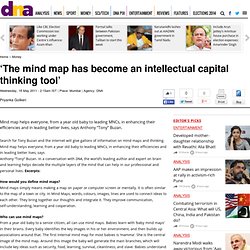
Search for Tony Buzan and the internet will give gallons of information on mind maps and thinking. Mind map helps everyone, from a year old baby to leading MNCs, in enhancing their efficiencies and in leading better lives, says Anthony “Tony” Buzan. In a conversation with DNA, the world’s leading author and expert on brain and learning helps decode the multiple layers of the mind that can help in our professional and personal lives.
Excerpts: Visual Thinking Evolution. A mind map is a diagram used to represent words, ideas, tasks, or other items linked to and arranged around a central key word or idea.

Especially in British English, the terms spidergram and spidergraph are more common,[1] but they can cause confusion with the term spider diagram used in mathematics and logic. Mind maps are used to generate, visualize, structure, and classify ideas, and as an aid to studying and organizing information, solving problems, making decisions, and writing.
The elements of a given mind map are arranged intuitively according to the importance of the concepts, and are classified into groupings, branches, or areas, with the goal of representing semantic or other connections between portions of information. Mind maps may also aid recall of existing memories. Mind Mapping, Concept Mapping, Argument Mapping: What are the differences and Do they Matter? (Martin Davies) Concept mapping, mind mapping and argumentmapping: what are the differences and do they matter?
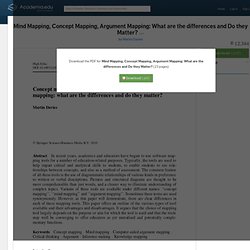
Martin Davies Springer Science+Business Media B.V. 2010 Abstract In recent years, academics and educators have begun to use software map-ping tools for a number of education-related purposes. The Mindmap Blog. iThoughts for iPhone adds integration with Siri, mind map galleries. Dec 19th, 2011 | By Chuck Frey | Category: Mobile Mapping Tools Craig Scott, the developer of iThoughts, has never been one to rest on his laurels.
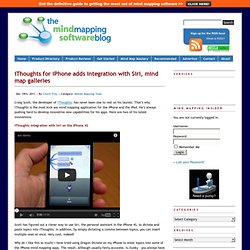
That’s why iThoughts is the most kick-ass mind mapping application for the iPhone and the iPad. He’s always pushing hard to develop innovative new capabilities for his apps. Here are two of his latest innovations: iThoughts integration with Siri on the iPhone 4S Scott has figured out a clever way to use Siri, the personal assistant in the iPhone 4S, to dictate and paste topics into iThoughts. Why do I like this so much? Integration with mind map galleries Using the latest iteration of iThoughts for the iPhone, you can now browse to BiggerPlate.com, select a map from the excellent gallery there, and import it into the app as shown in this video: You can also do the same thing with XMind’s mind map gallery. This opens up a world of possibilities for iThoughts users. Keep up the outstanding work, Craig! Mindmapping supports learning, study, memory.
Who invented mind mapping. I've seen comments around the web that say that Tony Buzan didn't invent mind mapping.
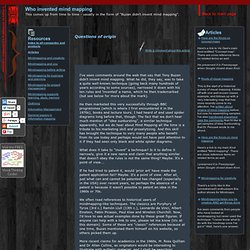
What he did, they say, was to take a quite well-known technique (going back many hundreds of years according to some sources), narrowed it down with his ten rules and 'invented' a name, which he then trademarked (but see below for more about the mark). He then marketed this very successfully through BBC programmes (which is where I first encountered it in the 1970s), books and lecture tours. I had heard of and used spider diagrams long before that, though. The fact that we don't hear much mention of "idea sunbursting", a similar technique apparently, but we do hear about Mind Mapping all the time is a tribute to his marketing skill and proselytizing. And this skill has brought the technique to very many people who benefit from its use today and perhaps would not have paid attention to it if they had seen only black and white spider diagrams. How I Use Mindmapping to Write. I use lots of tools for writing.
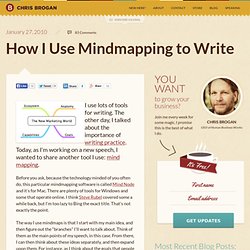
The other day, I talked about the importance of writing practice. Today, as I’m working on a new speech, I wanted to share another tool I use: mind mapping. Before you ask, because the technology minded of you often do, this particular mindmapping software is called Mind Node and it’s for Mac. There are plenty of tools for Windows and some that operate online. I think Steve Rubel covered some a while back, but I’m too lazy to Bing the exact title. The way I use mindmaps is that I start with my main idea, and then figure out the “branches” I’ll want to talk about. So, in this case, I just add a few ideas. Mind maps are a great tool for getting your jumbly thoughts into a framework. What happens, often, when we write, is that we look at sentences as this whole big thing.
That’s where mind maps excel (or one place where mind maps excel). What about you? ChrisBrogan.com runs on the Genesis Framework. Mindmapping resources. ‘The mind map has become an intellectual capital thinking tool’ - Money. Roy Grubb's Answers on Mind Mapping. My Mind Maps.